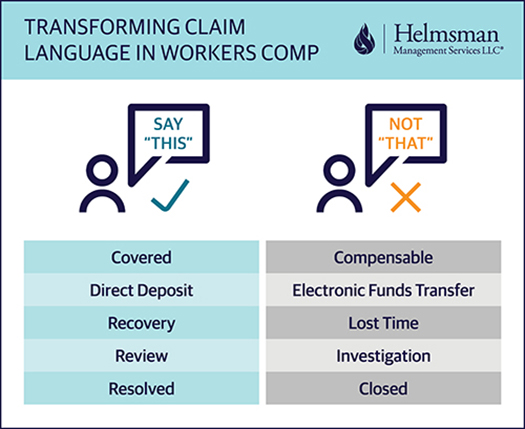Sponsored: Helmsman Management Services
How to Humanize Workers Comp and Make Worker Advocacy Real

The concept of injured worker advocacy is not new in workers comp.
“We strongly believe that taking a more holistic and human approach produces better claim outcomes for both injured workers and their employers,” said David Dwortz, President, Helmsman Management Services.
And with the strong economy and lack of skilled workers, this approach to worker advocacy is even more critical. “In the current business climate, there is a fight for talent. For businesses, there is strategic advantage in attracting and retaining top talent, and that includes those who have been injured on the job. Helping injured workers recover and return to work is more important than ever,” said Dwortz.
And yet, advocacy remains difficult to implement because it runs counter to the traditional workers comp model, which is typically task-oriented and lacks transparency.
“Claims begin with an investigation, which right off the bat sets a negative tone,” said Wesley Hyatt, Senior Vice President, Workers Compensation Claims, Helmsman Management Services LLC. “In the traditional model where only the compensable injury matters, injured workers can often feel as though no one truly cares about their well-being.”
To truly act as an advocate for injured workers, carriers and TPAs must take a deeper dive into their processes and rethink how to make every touch point with an injured worker an opportunity to create a positive experience.
Here are the hallmarks of true injured worker advocacy:
1. Eliminating Jargon and Speaking Simply to Avoid Confusion
Healthcare can be confusing enough on its own, but workers comp adds another layer of complexity.
“Getting injured already adds a lot of stress to a person’s life, and the workers comp process often makes it worse because it’s so confusing to navigate. It’s our obligation to make it as simple as possible, and we decided to start by explaining things in a way that injured workers can more easily understand,” Hyatt said.
Helmsman began reviewing conversations between claims specialists and injured workers to identify common terms and phrases that create confusion.

Phrases like “average weekly wage,” “IME appointment,” and “utilization review” may mean something to claims specialists, but only spark more questions for injured workers. They want answers to questions like: ‘what do I have to do to get better?’ and ‘how will I be paid while I’m out of work?’ Responding with simple and straightforward language removes some of the uncertainty that often comes with a workplace injury.
As one injured delivery driver shared, “After my injury, I was so nervous. What should I do? Who can I ask? What are my benefits? But [my claims specialist] was a saving grace. She walked me through the process and responded to my every question in rapid time. I felt really cared for.”
2. Making Convenience a Priority
An injured worker may not be able to take a claims specialist’s call in the middle of the day or may not have transportation to a medical appointment. Games of phone tag and missed appointments can delay recovery and increase frustration.
“To make the claims experience as easy as possible for injured workers, we need to engage with them in ways that are most convenient for them. That means incorporating technologies that they want to use,” said Dwortz.
For example, Helmsman sends each injured worker a personalized video message that explains the workers comp process from start to finish. The injured worker can watch the video on their own time, refer to it as needed, and get answers to many of their initial questions.
“We’re also piloting a ridesharing program to help injured workers get to their medical appointments,” said Hyatt. “They order the ride through an app on their smart phone just as they would for any other occasion and we cover the payment. Since the injured worker is using a familiar service, it’s one less thing for them to worry about.”
3. Anticipating Needs to Solve Problems Before They Start

Wesley Hyatt, Senior Vice President, Workers Compensation Claims, Helmsman Management Services, LLC
Anticipating an injured worker’s needs demonstrates that his or her wellbeing is a priority, and that the claims specialist is thinking about more than just the next item on the checklist.
When eight tornadoes touched down over the span of 12 days in May, for example, the Helmsman claims team reached out to workers living in the paths of those storms to offer help with accessing prescriptions, medical treatment, and claims payments.
“Our people took that initiative on their own—and that demonstrates a real shift in mindset. The focus first and foremost is on helping people. Most of the people we contacted were surprised and touched by the effort taken to make sure they were okay,” said Hyatt.
Proactive outreach can also include simple check-ins. Regular contact to see how an injured worker is doing reminds them that they are more than a claim or compensable injury — their wellbeing is truly a priority.
4. Employer Engagement

David Dwortz, President, Helmsman Management Services, LLC
Regular communication means even more when it’s coming from the injured worker’s own manager.
The employer plays a critical role in injured worker advocacy because a significant source of fear for injured workers comes from wondering whether their supervisors and colleagues think poorly of them, and whether their jobs will still be there for them in the end.
“Advocating for injured workers works best when the employer shares that same mission. For an injured worker, there’s nothing quite like having their manager express their support and a desire to have them back to work as soon as possible,” Dwortz said.
One company, for example, sends injured workers ‘get well soon’ cards post-injury. Others arrange additional services to help make the worker’s life whole while they recover, such as offering counseling through their own employee assistance programs and volunteer opportunities at local nonprofits through Helmsman’s transitional return-to-work program.
Empathy is at the Center of Everything
Investing in advocacy requires giving front-line claims staff the tools and knowledge they need to be effective communicators.
“The training can’t just be about the technical and medical components. We must train people on how to build that empathetic connection. Developing those soft skills is an ongoing process,” Hyatt said.
Nurses, for example, should be able to recognize and address an injured worker’s anxieties. Skills like motivational interviewing and therapeutic listening help get to the root of the worker’s emotional or psychological distress. Incorporating those factors into the care plan is critical for a smooth recovery and faster return to work.
It also benefits claims staff themselves. Helping people – rather than closing claims – adds meaning to the work and motivates them to do what’s best for injured workers.
Taking Advocacy to the Next Level
Plenty of data shows that treating the whole person reduces claim duration, medical and indemnity costs, litigation rates, and lost productivity for the employer. But improving these metrics should not be at the heart of what drives advocacy for injured workers.
Rather, they are a byproduct. The most important outcome is a happy and healthy worker who returns to full functionality and normalcy as quickly as possible, and who shares the feeling of this injured wholesale worker:
“I can’t thank you enough for the outstanding help that has been given to me over the last few months. This journey that life is taking me on has been made a lot easier with your prompt and compassionate service that has been and still continues to be given to me.”
Advocacy has always been at the core of Helmsman’s culture, and it requires a continuous effort to keep injured workers at the center of the story.
“Advocacy has always been in our DNA, and now we’re taking it to the next level. We are shifting the mindset from ‘How do I get this claim closed?’ to ‘How do I help this person?’ It’s a rewarding journey for everyone involved in the process,” Dwortz said.
To learn more, visit https://helmsmantpa.com/.










